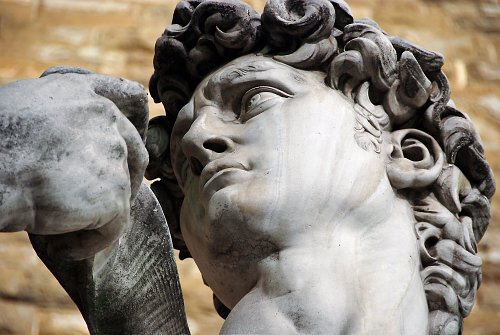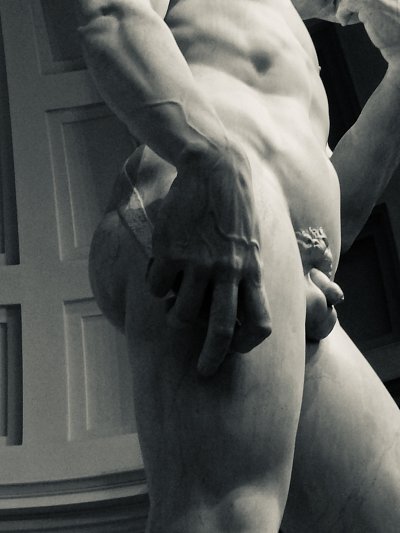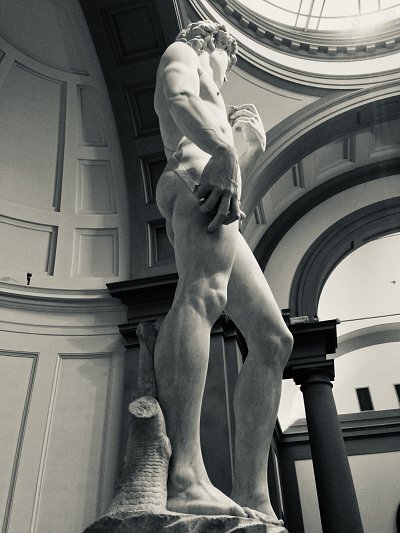Michelangelo's David
The Original Michelangelo's David at Accademia Gallery in Florence

Giorgio Vasari does, above all, shortly express the wonder of one of the greatest works ever made by man.
At the Accademia Gallery, visitors can feel close to the perfect beauty of the most famous sculpture in Florence—and maybe even world-wide: Michelangelo's David. It comes from the Renaissance; this striking sculpture is between 1501 and 1504.
It is a marble statue of 14.0 feet showing the Biblical character David; it stands upright as a male nude. Its commission was originally by the Opera del Duomo for the Cathedral of Florence; they planned this to be one among many large statues to fill the nitches of the cathedral's tribunes, located around 80 meters from ground level.
The board consuls asked Michelangelo to complete work that had been started in 1464 by Agostino di Duccio and then passed on to Antonio Rossellino in 1475.
Ultimately, both sculptors had abandoned this massive block of marble, deeming it unfit based on the numerous "taroli," or flaws, risking the stability of such a large statue. Consequently, this block of marble, exceptionally large, went for twenty-five years untouched in the courtyard of the Opera del Duomo (Vestry Board). The marble for the statue was cut from the quarries at Carrara, although several Florentine sculptors had followed Michelangelo to Carrara and were hired to assist in transferring the blocks from Carrara to Florence.
Once they had arrived at their destination, local laborers worked with no knowledge of what they were doing until the shape emerged, almost by magic. On August 16, 1501, the opera del Duomo of Florence assigned to Michelangelo's David with a payment order of 400 ducats. A number of famous artists of that age including Leonardo da Vinci, Sandro Botticelli and Filippino Lippi as well as il Perugino decided on January 25th in 1504 that this statue should be placed by the entrance to Palazzo Vecchio symbolizing power and freedom of Florentine people.
On September 8th his work was presented to the city with general admiration. Initially certain elements of David were gilded: among them a garland atop his head (to keep intact) and a broncone behind right leg (or "bronzino"), which was rusted or worm-eaten now cast in bronze; also slings went gilded. The sculpture stands at 517 cm high and weighs some 5560 kg with itself standing on an intricately carved base. Periodically between 2003-04 it underwent tapes removal dusting too for frequent cleaning perpetuation in scientific interest.
By 1501, at the young age of twenty-six, Michelangelo was not only the most famous but also the highest-paid artist in all Italy. Welcoming with enthusiasm the task of creating a colossal David, he labored for more than two years with unremitting toil and produced one of his most spectacular works: a marble figure in dazzling white.


The Myth of David and Goliath
The Vestry Board had set a religious theme for the statue, but no one expected this radical rendering of the biblical character.
The story of David and Goliath is told in the book of 1 Samuel. The Philistines come into conflict with the Israelites, who are led by Saul, at a point near the Valley of Elah.
Their champion, Goliath, steps out from the lines of Philistines for 40 days twice daily and challenges them to send their own champion to combat him as a resolution for single combat. Now comes forward a very young shepherd boy named David. Although Saul hesitates he finally agrees and tries to have his armor put on David, but this does not fit him; then he took his staff in his hand, chose five smooth stones from the wadi, and put them in his shepherd's bag, in the pouch; his sling was in his hand, and went toward the Philistine So, Goliath and David faced each other with Goliath in his armor and shield in hand while David is only described as standing armed with his rock, a sling, courage and faith in God. Running towards the giant, heaving his homemade sling over his head around and around to build momentum then releasing one of the stones from its pouch loaded at the far end spirals through the air until it connects with Goliath's forehead.
Sending Goliath staggering first backward and then down to his knees before falling flat on his face allowing David to finish him by beheading the giant. Historically, David has been depicted standing over the fallen Goliath in a triumphant pose. Florentine artists such as Verrocchio, Ghiberti, and Donatello all produced their own versions of David with his foot on Goliath's severed head. Michelangelo astoundingly chooses to show David before the fight for the first time ever. He is captured here in a moment of intense focus at the very point when he first encounters Goliath, by tension yet gracefully static — contrapposto was an established classical pose meaning "against which it is placed" — with one leg taking the body's weight and an engaged leg while hips/shoulders rest at opposing angles creating subtle s-curvature through torso.
The almost invisible slingshot slung over his back tells us that David's victory came from something other than pure strength; it was an act of ingenuity. He has an extraordinary amount of self-confidence and concentration, values of a "thinking man," highly regarded during the Renaissance period.

The archive documents reveal that Michelangelo worked on the statue in dead silence, hiding his masterwork until January 1504. He worked in an open courtyard and used to get wet whenever it rained.
This might well have inspired the eccentric method of working attributed to him: he is said to have made a wax model of what he designed and then immersed this in water.
As he worked at his carving, he would let the water level go down and then, underneath different kinds of chisels, cut out what became visible.
His sleep was irregular; when he did go to sleep, he kept on even his clothes— and his boots— and scarcely ate, as recorded by his biographer Ascanio Condivi More than two years after he started working on it, Michelangelo decided to show his "Giant" to the Vestry Board members and Pier Soderini, who was gonfaloniere of the Republic at that time. In January 1504, his fourteen-foot tall David was revealed only to them, and all were of the opinion that it was too perfect for the high cathedral.
Therefore, alternative sites within the city were considered.
The city council formed a special committee of about thirty members (including some artists like Leonardo da Vinci) to decide where best to place the statue. Nine different locations were suggested amid much debate before finally being installed at one of Florence's political centers, Piazza della Signoria. Thanks to its striking perfection, the figure of David came out as a symbol of liberty and free Republican ideals, showing the readiness of Florence to defend itself. It stood in front of the Palazzo Vecchio until 1873 when it was moved to the Galleria to protect it from further decay and wear. Today, thanks to a skylight designed by Emilio de Fabris in the 19th century for this express purpose, visitors can see the David.
It unveils from up close Michelangelo: his deep knowledge of the male figure and extreme love for human anatomy. Note the watchful look with sculpted eye sockets, and veins on the back of the hands standing out with tension. See the curve of the solid midsection and muscles in the right leg tightening up. Some details show proportions that are not typical of Michelangelo. It has a very large head and a right hand in a commanding position.
Maybe these exaggerations are due to the fact that the statue was intended to be seen when placed at the roofline of the cathedral and, therefore, some key features of the sculpture had to be exaggerated for easy visibility from below. Another analysis of the broader aspects suggests that Michelangelo intentionally magnified the size of the head to denote concentration, while the right hand signified an action with a sense of purpose.
Curiosity about The David
- Who made the David?
-
The Tuscan Renaissance genius man that knows as the artist named Michelangelo Buonarroti.
- When was the David made?
-
Between 1501- 1504 (restored in 2003-2004) – Michelangelo started the work when he was just 26 years old.
- Where is Localed?
-
The original is exposed at the museum called the Accademia Gallery, in Florence, Italy.
A copy (a little bit bigger) is public exposed at the Signoria's Square in the earth of Florence town.
- How tall is The David?
-
5.16 meters (almost 17 feet, a shy short at 16 feet and 11.15 inches).
- What is it made of?
-
One single block of marble from the quarries in Carrara in Tuscany, one of the whitest in the world.
- How much the David weight?
-
5,660 kg or 12,478.12 lbs. He is made out of solid marble.
- Did you know that...
-
On the original statue the sling on his left shoulder and tree trunk behind his right leg were covered with gold leaf? Being outdoors in Piazza della Signoria in the elements for over 400 years washed the gold leaf away.
So this is one of the reasons why the original David has moved into the Accademia Gallery.
- What's the meaning of the statue?
-
Found in the Book of 1 Samuel, the biblical tale of David and Goliath features a young David in the lead who is pitted against the giant Goliath. Because he was of small stature, David could not use brute force to defeat his enemy. Hence, the victory was his own with cunning and skill, using a slingshot to defeat someone much bigger than he was.
Several statues by various artists pre-Michelangelo also depicted the subject of David after he had killed Goliath, normally showing the severed head at David's feet. Michelangelo defied tradition and chose to show his David before the fight. The expression on his face is one of deep thought as he ponders his tactics, with a rock hidden in his right hand and a slingshot placed over his shoulder, feigning nonchalance while actually waiting for the perfect moment. A giant could only be defeated by catching him unawares—and he was!
